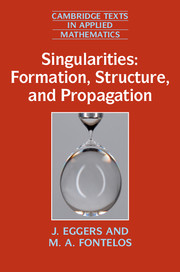Book contents
- Frontmatter
- Dedication
- Contents
- Preface
- PART I SETTING THE SCENE
- PART II FORMATION OF SINGULARITIES
- PART III PERSISTENT SINGULARITIES: PROPAGATION
- 11 Shock waves
- 12 The dynamical system
- 13 Vortices
- 14 Cusps and caustics
- 15 Contact lines and cracks
- Appendix A Vector calculus
- Appendix B Index notation and the summation convention
- Appendix C Dimensional analysis
- References
- Index
15 - Contact lines and cracks
from PART III - PERSISTENT SINGULARITIES: PROPAGATION
Published online by Cambridge University Press: 05 September 2015
- Frontmatter
- Dedication
- Contents
- Preface
- PART I SETTING THE SCENE
- PART II FORMATION OF SINGULARITIES
- PART III PERSISTENT SINGULARITIES: PROPAGATION
- 11 Shock waves
- 12 The dynamical system
- 13 Vortices
- 14 Cusps and caustics
- 15 Contact lines and cracks
- Appendix A Vector calculus
- Appendix B Index notation and the summation convention
- Appendix C Dimensional analysis
- References
- Index
Summary
Driven singularities
In this chapter we discuss two examples of singularities whose motion is controlled by a balance of external driving on a large scale and energy dissipation on a microscopic scale: the first is contact line motion and the second is crack propagation; see Fig. 15.1. As these problems are very different in their physical manifestations they are rarely discussed together, yet their mathematical structures are very similar. In the contact line problem the singularity occurs at the edge of a drop, the so-called contact line. In the crack problem the singularity is at the tip of the crack.
The core of the problem is an intermediate region, which represents the universal singularity and which connects the small and large scales. Toward large scales the intermediate solution matches to an outer solution, which represents the specific geometry of the problem, for example the shape of the elastic body and its loading (in the crack problem) or the shape of the drop (in the contact line problem). Toward small scales the singularity is cut off by phenomena that take place on a microscopic scale and are therefore dependent on the specific system under study.
In both cases it is instructive to consider the problem from the point of view of the energy flux through the system. The energy input is supplied from the large scale and is consumed on the microscopic scale. The balance between the two determines the propagation of the singularity.
A spreading drop
Three-phase contact lines occur very commonly, for example when a drop of water is attached to a windowpane. In this case the drop is bounded by a line where water, glass, and air meet. Very often these contact lines are observed to move; the drop runs down the windowpane or a drop placed on a flat surface spreads. It would seem a straightforward exercise to describe this motion using the equations of fluid motion: inside the fluid drop we solve the Navier–Stokes or Stokes equations, subject to a boundary condition of vanishing shear stress on the free surface and a no-slip condition on the solid. However, solutions to the continuum equations in which the contact line is moving do not exist.
This difficulty arises because at the contact line the velocity field becomes multivalued.
- Type
- Chapter
- Information
- Singularities: Formation, Structure, and Propagation , pp. 390 - 426Publisher: Cambridge University PressPrint publication year: 2015



